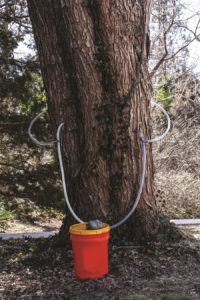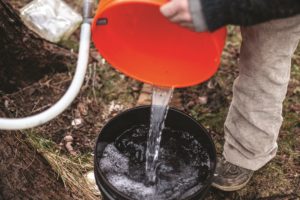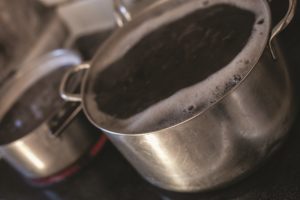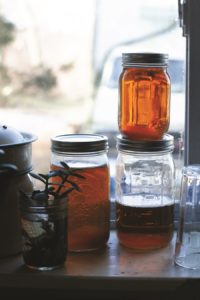The Outer Cape is known for many culinary delicacies: Eastham turnips, Wellfleet oysters, and Provincetown’s seafood-laden Portuguese stews. But maple syrup? That’s long been the pride of our neighbors to the north.
There are a few maples around, though. And I know at least one person who makes maple syrup here.

Toby Storer, my father, began tapping a large maple tree in the center of his Wellfleet yard seven years ago. He is a shellfisherman, so for most of the year he’s occupied harvesting clams or scallops. But right now he’s busy collecting sap from that maple and one other that stands nearby.
The maples have not yet budded, but the green shoots of daffodils pierce the ground by the base of the tree. Native Americans traditionally take the first sighting of a crow as a sign to begin harvesting sap. Now is the time for syrup production.
“I usually start at the end of January, after the first hard freeze starts to thaw,” he says. Timing-wise, what he’s looking for are waning winter’s temperature fluctuations. “If it’s in the 20s at night and in the 30s or 40s in the daytime, the sap is likely to flow,” he explains.
“I put a hole in a different place each year,” my father says, pointing to one of the spouts on the tree. Well-spaced holes will protect the tree’s health. He uses a 7/16 bit to drill two inches into the tree and plugs the hole with a barbed, half-inch plastic hose coupling to ensure a tight fit. Completing his D.I.Y. setup is ⅝-inch plastic tubing, which connects the tap to a five-gallon bucket on the ground. A tightly covered lid on the bucket keeps out rainwater and dirt, while a T-hose connector and half-inch hole allow gravity to bring the sap in.

On a February morning, I follow my father as he checks on his taps. Overnight production from two trees and six taps filled a five-gallon bucket with a clear liquid that tasted like slightly sweetened water. It will take about 40 gallons of this sap to produce one gallon of syrup.
After hauling the bucket into a kitchen already steamy from boiling pots and cluttered with mason jars, he filters the sap with repurposed scallop bags and puts it on to boil.
He uses a sieve to skim off brownish foam, removing impurities. The liquid will also be poured through coffee filters toward the end of the process to remove “sugar sand,” a grainy sediment produced in the boiling process.
The syrup is done when it reaches 217 degrees F, measured with a candy thermometer. “The bubbles climb up the side of the pan like a volcanic eruption,” says my father, describing the final stages. “When this happens, you know it’s maple syrup material.”

The syrup is processed the way homemade jam is, poured into sterilized glass jars and then boiled in a large pot for five to ten minutes to seal the jars and ensure the syrup is preserved until opened. The syrup from earlier in the season is a light amber color and delicate; this harvest is dark and full-flavored.
Producing sugar from maple trees is a tradition with a long history in North America. Native Americans maintained sugar camps before colonists arrived. The Europeans were astonished by the sugary bounty sourced from common trees.

Benjamin Rush, a physician and signer of the Declaration of Independence, saw the maple tree in terms both mystical and political. As an opponent of slavery, he joined a movement of Quakers, promoting maple syrup as an alternative to sugar cane, which was harvested largely by enslaved workers. He wrote to Thomas Jefferson, “I cannot help contemplating a Sugar Maple Tree with a species of affection, and even veneration.”
In my father’s time, hobbyists and back-to-the-land enthusiasts were drawn to sugaring. Helen and Scott Nearing’s The Maple Sugar Book sits on top of my dad’s refrigerator. Written in the 1950s by leftist urban escapees, this book makes a case for maple syrup as a family craft that stands in opposition to big business and deforestation. Sugaring, they say, promises “absorbing interest, health, vitality, and recreation, as well as food and a modest income.”
There’s no saying if Toby Storer’s Wellfleet maple syrup will be on the market soon. But maybe next year you’ll look at your maple tree differently, if you have one, and let the sugar flow.
